#Late 3rd century – 4th century AD
Text

MOLD-BLOWN BOTTLE of Hans van Rossum
Late 3rd century – 4th century AD | Eastern Mediterranean, probably Syria
Size↑9.7 cm | ø 5.7 cm (body) | Weight 72 g
Technique: Body blown in a mold with two vertical sections. Neck and rim free blown, handles and coil applied.
Description: Transparent olive green glass, lens-shaped body, circular in front elevation. Cylindrical neck, flaring rim folded inward. Base indented with roughly cut off profile. Mold-blown decoration on body; on front and back, two concentric raised circles surrounded by rosette and twenty raised petals; on the perimeter, two rows of graduated circles with central bosses alternating with pairs of small bosses. Two opposed angular handles applied on the shoulder, drawn up and down, folded and applied to edge of rim. Probably the glassmaker had no good sense how to divide the amount of glass he needed; one handle is wide and massive, the other small and thin. The same with the trail around the neck; starting with a big drop, continuing in a thick coil, he ended the coil ring around the neck in a hairline trail. Pontil mark.
Condition: Intact, some slightly incrustation
Remarks: The same mold-blown design of concentric circles surrounded by a rosette was already used by the glass blowers during the first century AD. An example of this early mold-blown glass vessel is part of the Borowski Collection, no. V-52 and another one was part of the Collection of Monsieur Demeulenare no. 130. The early types however have different characteristics like form of the handles and the rim. They also does not have rows of circles on the sides. An identical example, made in blue glass, was formerly part of the Sheldon Breitbart Collection. It is striking identical with this example, except the way in which the handles are folded at the top. This blue one however is dated in the first century, so there is a friction in dating this type. Author of this book however prefers a dating in the third or fourth century AD, especially because of the thickness of the glass and the way in which the handles are formed. Mold-blown flasks with vague designs of concentric circles as on this example were first blown into a two-part patterned mold and after that inflated so the design could become barely visible.
Provenance: Private collection USA
Published: Arte Primitivo New York, auction 28 October 2009 lot 300
Reference: Glass from the Ancient World, the Ray Winfield Smith Collection, no. 253, H = 14.3 cm, The Breitbart Collection of Antiquities and Ancient Glass, Sotheby’s 20 June 1990, lot 85, Christie’s Antiquities, auction 8 April 1998 lot 15, Roman Glass in The Corning Museum of Glass – Vol. II, D. Whitehouse no. 638, Gorny & Mosch Munich, Auktion Kunst der Antike no. 202, 14. Dezember 2011 lot 113. H = 9.2 cm (one handle)
41 notes
·
View notes
Text
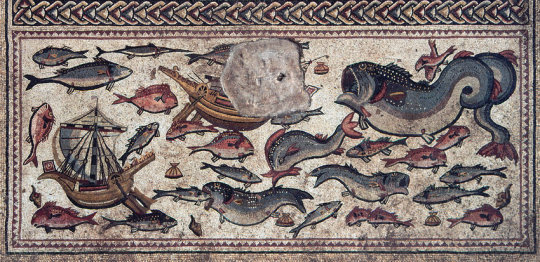
The Lod mosaic, discovered in the city bearing that name in Israel, was laid in a luxurious villa urbana in the late 3rd or early 4th century AD.
It contains inter alia a nautical scene presented as a carpet in the form of a pond. The scene includes sea life and two merchant ships.
#naval art#naval history#roman mosaic#nautical sea#merchant vessels#at sea#late 3rd century- early 4th century ad#ancient seafaring
171 notes
·
View notes
Text
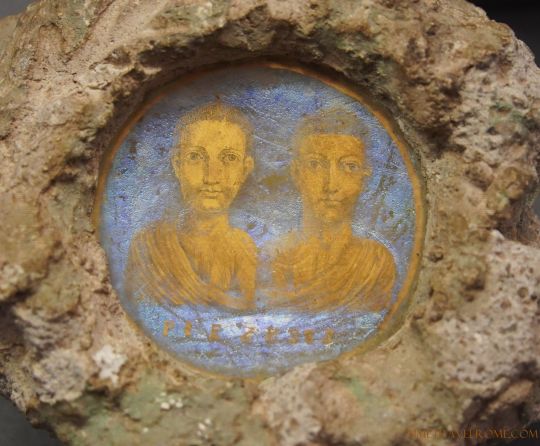
"Gold-glass portrait of two young men from the Museo Civico Archeologico in Bologna. Produced in the 1st quarter of 4th century, it bears a Latin transcription of Greek: PIE ZESES, or "Drink and you will live". This particular double portrait was pressed into the fresh mortar on the burial niche - the remains of the mortar can still be seen. Glass portraits were produced placing & fusing gold leaf between two layers of glass. First found in Hellenistic Greece, they became characteristic of the Roman glass of the Late Empire in the 3rd and 4th century AD."
Text and photography by Time Travel Rome
62 notes
·
View notes
Text

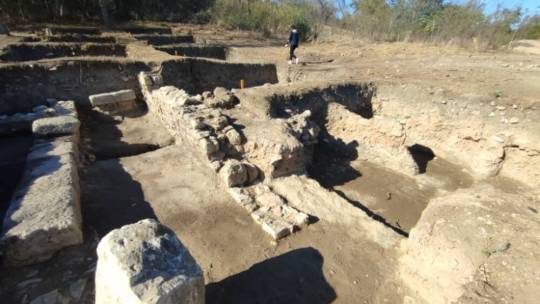
Archaeologists Discovered Roman Floor Mosaics in Bulgaria
Archaeologists discovered floor mosaics with early Christian designs and nearly 800 artifacts in the archaeological reserve of Marcianopolis in Devnya, in the northeastern part of Bulgaria.
The Roman town of Marcianopolis (present-day Devnya) in northeastern Bulgaria appears to have originated as a Thracian settlement. It was later inhabited by Hellenized settlers from Asia Minor and named Parthenopolis.

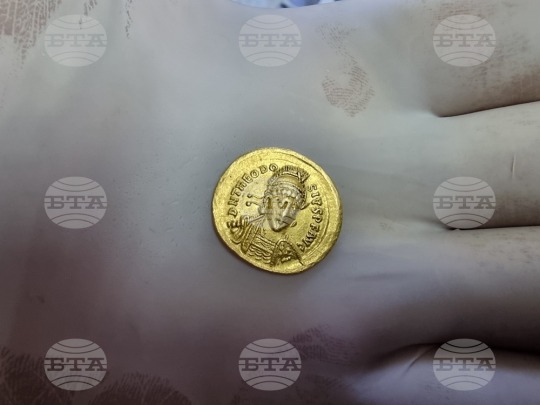
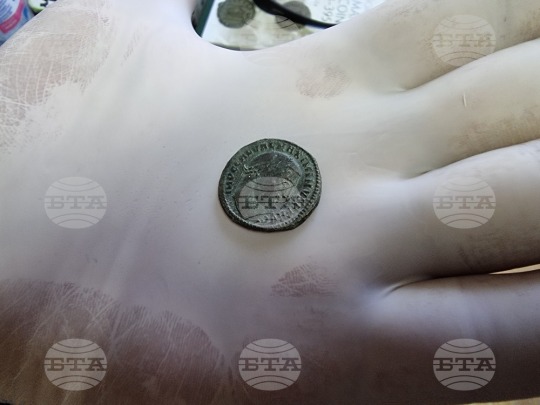
Roman Marcianopolis was established around 106 CE, following Trajan’s campaigns in Dacia to the north. The settlement was named after his sister, Ulpia Marciana. At the crossroads between Odessos (modern Varna), Durostorum, and Nicopolis ad Istrum, as well as the location of plentiful springs, Marcianopolis became a strategically important settlement.
Diocletian’s administrative reforms in the late third century CE divided Moesia Inferior into Moesia Secunda and Scythia Minor, with Marcianopolis serving as the former’s administrative capital. Marcianopolis experienced its most prosperous period during the middle of the fourth century CE. From 367 CE to 369 CE, the eastern emperor Valens used Marcianopolis as his winter quarters during campaigns against Visigoth incursions in the region. During this time, it served as the Eastern Empire’s temporary capital.

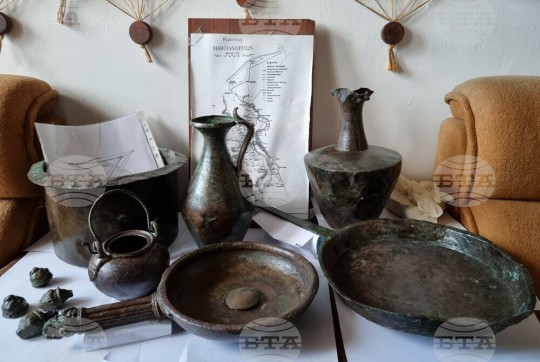

Floor mosaics with early Christian designs were found in the remains of a building. Archaeologists are not yet sure whether it was a public building or it belonged to a rich Roman citizen.
The tentative dating of the mosaics is in the first half of the 4th century AD.
The finds from the current archaeological season in Devnya contain another thousand bronze coins, several clay lamps and two clay vessels, which are awaiting scientific processing and restoration.
During the past archeological season, researchers restored bronze vessels discovered in the 1990s in a brick-walled tomb dating to the late 2nd – early 3rd century.
The vessels had a ritual use and were related to the personality of the person buried, Mosaic Museum director Ivan Sutev said in a statement to BTA.


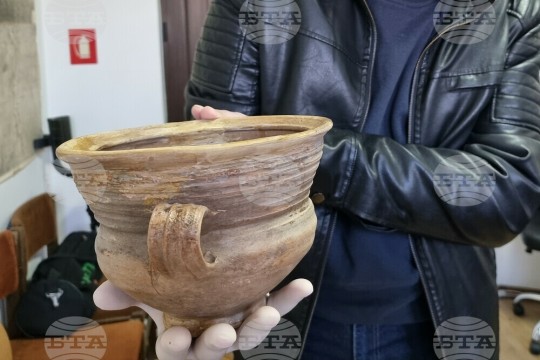

They are richly decorated and the workmanship is exquisite, he added. The find includes a vessel for pouring liquids as offering to a deity, and a wine jug with a trefoil mouth (oenochoe). A simple kitchen pan was also found along with these. All this leads archaeologists to suggest that a Roman citizen of Marcianopolis may have been laid to rest in the tomb, but that he may have had more specific functions: a soldier, a cook, or even a priest, Sutev said.
Pottery that was discovered in the basilica’s environs during excavations in 2023 has since been restored. Among these are a mortarium vessel for liquids and an exquisite crater-shaped pot for liquids. These were located in the structure with the mosaic floors. Coins from the time of Emperor Theodosius II were also found scattered on the floor.
In 447, Attila’s Huns captured and destroyed Marcionopolis after conquering the entire Balkan Peninsula but failing to capture Constantinople. That is determined by 20 gold coins scattered on the floor of the building being studied. On one side of the coins is an image of Theodosius II, while on the other is the patron goddess of Constantinople. Among the coins discovered during the Marcianopolis excavations were those from the city’s founding in the second century. The latter are dated to the sixth century, around the time of Emperor Justinian.
By Oguz Buyukyildirim.
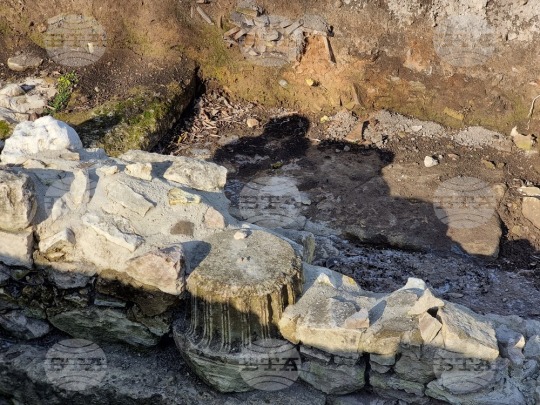
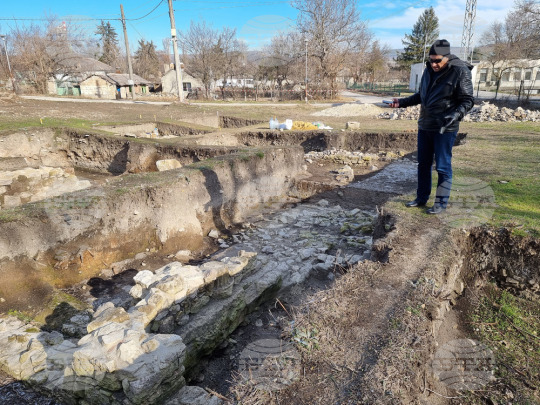
#Archaeologists Discovered Roman Floor Mosaics in Bulgaria#The Roman town of Marcianopolis#gold#gold coins#roman gold coins#ancient artifacts#archeology#archeolgst#history#history news#ancient history#ancient culture#ancient civilizations#roman history#roman empire#roman art#Emperor Theodosius II
44 notes
·
View notes
Photo

Undyed linen and dyed wool tapestry bands (Late Roman, Egyptian, late 3rd to 4th century AD).
Images and text information courtesy MFA Boston.
69 notes
·
View notes
Text

Gold "crossbow" fibula, Roman, late 3rd-early 4th century AD. Inscribed "HERCVLI AVGVSTE SEMPER VINCAS (May you always be victorious, Hercules Augustus!)"
from The Metropolitan Museum of Art
161 notes
·
View notes
Text
goethe starts writing Faust around 1773 at the same time at his Werther, starting from the "bleak day" scene which is the dramatic core around which the rest of the tragedy develops, and which sets the themes of the abandoned girl who drowns her baby and is now imprisoned. it's written entirely in prose. he continues this work when he relocates to Weimar, composing the first version of the tragedy afterwards known as Urfaust, never published during his lifetime. the Urfaust is only rediscovered in the late 19th century, through a copy preserved by a lady-in-waiting.
the Urfaust is missing some of the main nodes of the story: there is no pact between the devil and Faust, there is no Walpurgisnacht, no scene of the rejuvenation of Faust, nor Wald und Höhle, one of the most lyrical scenes of the first part of the poem, and there is no scene where Faust kills the abandoned girl's brother. it's only after 1788, during Goethe's trip to Italy, that he adds some of these crucial passages (the rejuvenation, the lyrics, and a considerable rework of a farcical scene in a tavern). he publishes this version as Ein Fragment, in 1790, where however he removes some of the final sections that were on the other hand present in the unpublished Urfaust. the bleak day scene and the final jail scene are removed, eschewing the true heart of the tragedy.
only after 1794, after becoming friends with Schiller who keeps nagging him, does he continue working on the story. so from 1797 he adds the dedication, the prologue in a theatre, a meta scene on the dramatic arts, and the prologue in heaven, where the devil and God strike up a bet of their own about Faust's final fate. he continues with adding more scenes around the main plot and only leaves out a satire of academia. finally there's Walpurgisnacht, the murder of the brother, and most importantly, the deal/bet with the devil. in 1805 Schiller dies, Goethe convinces himself to publish a new edition of his works, and in 1808 comes out the first part of the tragedy. all scenes have been rewritten in poetry and the black day scene is the only one surviving in its original prose form. in this time, Goethe also sketches down the 3rd and 5th acts of the second part.
it isn't until 1816, eleven years later, when Goethe is working on a biography and has to write down how Faust came to be, that he goes back to the notes on the poem and tries to put down a scheme of how the second part was meant to happen. there's existing notes that maintain the dramatic structure of the first part, and the conflict between Faust and Mephistopheles and their bet as its core, but these notes are scrapped. in 1825 Goethe returns to his life's work and reworks it allegorically. he changes up some things about the invocation of Helen of Troy, who no longer appears in modern Germany; rather, it's Faust who seeks her in Greece. in 1826 the 3rd act is finished and the Helen fragment is published separately.
at this point Goethe considers finishing the poem his only remaining goal and works on it until the very last day of his life. he finishes the 5th act and writes the 4th last, then seals up the manuscript, and reopens it a few days before death to change up a few sentences. the second part of the tragedy is published posthumously in 1832, the same year as his death.
I made this write up to see if I could remember the whole deal for an exam tomorrow, thanks for your attention.
12 notes
·
View notes
Text




Cleveland Warehouse District
W. 6th Street and St. Clair Avenue
Cleveland, OH
The historic Cleveland Warehouse District, a nationally recognized historic district located iin downtown Cleveland, Ohio, is roughly bounded by Front and Superior Aves. and Railroad, Summit, W. 3rd, and W. 10th Sts.; also 1384-1410 W. 10th St. (10th St. addresses represent a boundary increase). In the first half of the 19th century, this neighborhood was part of Cleveland's original residential area. Later in the century, it became the center of Cleveland's wholesale commercial area, and was occupied by warehousing and distribution terminals for more than 100 years. But after warehouse traffic moved elsewhere, it fell into serious disrepair with empty, run-down warehouses. The area is historically anchored by major skyscrapers that echo Cleveland's industrial past, most notably the Rockefeller Building. In Cleveland's Warehouse District, northwest of Public Square, the historic Hilliard Building stands on the corner of West 9th Street and Frankfort Avenue as the oldest commercial building in downtown Cleveland.
In the late 1970s, the Warehouse District underwent major renovation and revitalizing, with the buildings being repurposed as bars, restaurants, shops, nightclubs, and apartments for people seeking to live downtown, and eventually became a nightlife hotspot for 20-somethings and urban professionals, following a pattern pioneered in Cleveland by the Flats entertainment district, which it ultimately supplanted as the city's premier weekend place-to-be. The metamorphosis to the Warehouse District's current state began with the opening of Hilarities Comedy Club in the late 1980s (Hilarities has since moved to E. 4th Street). The transformation of the district initially sought to attract artists in live-work spaces, but rent and popularity became too high, and drove artists to nearby Cleveland neighborhoods of Tremont or the St. Clair Superior.
Artists Steven B. Smith and S. Judson Wilcox were two early "urban pioneers": artists who settled the Warehouse District in Cleveland in 1981. Artists, musicians and renegades moved there to revel in Cleveland's industrial beauty. Smith's spot in the warehouse became a gathering spot for other artists in the building. Spaces Gallery was located on the first floor, making the warehouse the de facto epicenter of creative activity. Although more than half of the original eight-block area has been razed and replaced by parking lots, by 2000 the remaining restored buildings were home to many restaurants and clubs. West Sixth Street is known as the heart of the district where various nightclubs, bars, and high-end restaurants are located.
The neighborhood has also seen many of the rehabilitated warehouses converted to office and residential space. The ornate Victorian age facades of these historic warehouses are often preserved and restored, while the interiors of the buildings experience complete transformation into contemporary and trendy spaces. Its apartments and condominiums have been responsible for a large portion of downtown Cleveland's recent population growth. Most of the remaining structures have been rehabilitated, and developers have started to plan and build infill construction projects. On September 30, 1982, the district was added to the National Register of Historic Places as the Cleveland Warehouse District. On February 21, 2007, its boundary was increased to include 1384 to 1410 West 10th Street.
0 notes
Text
Like the Scythians to whom they were closely related, the Sarmatians were highly developed in horsemanship and warfare. Their administrative capability and political astuteness contributed to their gaining widespread influence. By the 5th century BC the Sarmatians held control of the land between the Urals and the Don River. In the 4th century they crossed the Don and conquered the Scythians, replacing them as rulers of almost all of southern Russia by the 2nd century. The Roman province of Lower Moesia (Bulgaria) was penetrated during the time of Nero’s rule, and an alliance which the Sarmatians formed with Germanic tribes posed a formidable threat to the Romans in the West as late as the lst century AD. In the final centuries of their existence the Sarmatians invaded Dacia (Romania) and the lower Danube region, only to be overwhelmed by the Goths during the 3rd century AD, though many of them joined their conquerors in the Gothic invasion of western Europe. Sarmatia perished when hordes of Huns migrated after AD 370 into southern Russia. Those surviving became assimilated or escaped to the West to fight the Huns and the last of the Goths. By the 6th century their descendants had disappeared from the historical record.
0 notes
Photo

THE VARNA TREASURE
31. THE VARNA TREASURE
The treasure was fortuitously found in Varna in 1961, during construction works, at the corner of Knyaz Boris I and Makedonia streets, 1,5 m be-low the today’s walking level. The spot is about 500 m north – east to the Late Antiquity fortress walls of Odessos, near the Roman necropolis of the town (AD 2nd – 3rd centuries). At the area of the find there is evidence of funerals dating from the 4th – 6th centuries.
It has been probably kept within a leather sa-chet and might have been part of a larger treasure
consisting of gold jewelry belonging to ecclesiastical or secular persons. The presence of additional artifacts and fragments suggests the treasure has been divided in two parts at least, and submitted by the Church or by Odessos authorities in the second half of the 6th – early 7th century to Barbarians (probably the Avars who invaded the Balkans in 580 – 582) in return for captives; the local bishop Martin attested to a similar initiative — in 544 he succeeded in receiving from Emperor Justinian a special privilege for the church community in town (Just. Nov. CXX, 4)
The treasure consists of eight objects or frag-ments of 22-carat gold, precious and semi-precious stones: pearls, garnet and malachite of a total weight of 417 g. They were produced in different periods between mid 5th and mid 6th centuries, using various techniques peculiar of the Early Byzantine goldsmith’s art as forging, engraving, chasing, filigree, granulation, incising, intaglio and encrustment. Some of the pieces were prob-ably fashioned in the imperial workshop of Con-stantinople, as the bracelets tour bulgaria, the incised diadem which is the only one known of its kind, and per-haps the necklace. The rest of the jewels were like-ly produced in the workshops of Odessos, which were very active in the course of 4th – 6th centuries.
31.1. DIADEM
Constantinople Second half of the 5th century Gold, pearls, green gems (emeralds?) 32,5 x 1,3 cm; 16,4 g
31.2. DIADEM A fragment Odessos 6th century Gold, opal, pearls, glass 19 x 1,3 cm; 40,8 g Varna, Regional Museum of History, lnv. N III 560
31.3. NECKLACE
Odessos
Late 5th – 6th century Gold, pearls, glass L. 25,6 cm; 25,6 g Varna, Regional Museum of History, lnv. N III 561
31.4. PECTORAL CROSS -ENCOLPION
Odessos 6th century Gold, garnet, malachite 7,3 x 5,2 x 0,75 cm; 37,5 g
Byzantium
Second half of the 6th century Gold, filigree, amethyst 3,9 x 2,5 cm Sadovets, Pleven region, discovered during archaeological research in 1934, in the vicinity of a Late Antiquity fortress together with 54 gold coins and 50 copper coins dating from the reign of Justinian (527 – 565) to Maurice Tiberius (582 – 602)
31.5. BRACELET
(the other one of the pair is now in a process of conservation) Constantinople 6th century Gold, pearls, glass, enamel 6,3 x 3,4 cm; 109,4 and 112,3 g Varna, Regional Museum of History,
0 notes
Photo
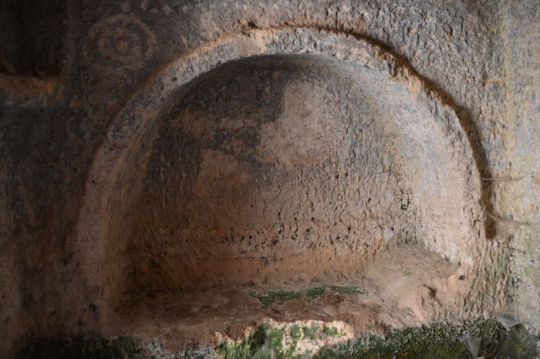
THE VARNA TREASURE
31. THE VARNA TREASURE
The treasure was fortuitously found in Varna in 1961, during construction works, at the corner of Knyaz Boris I and Makedonia streets, 1,5 m be-low the today’s walking level. The spot is about 500 m north – east to the Late Antiquity fortress walls of Odessos, near the Roman necropolis of the town (AD 2nd – 3rd centuries). At the area of the find there is evidence of funerals dating from the 4th – 6th centuries.
It has been probably kept within a leather sa-chet and might have been part of a larger treasure
consisting of gold jewelry belonging to ecclesiastical or secular persons. The presence of additional artifacts and fragments suggests the treasure has been divided in two parts at least, and submitted by the Church or by Odessos authorities in the second half of the 6th – early 7th century to Barbarians (probably the Avars who invaded the Balkans in 580 – 582) in return for captives; the local bishop Martin attested to a similar initiative — in 544 he succeeded in receiving from Emperor Justinian a special privilege for the church community in town (Just. Nov. CXX, 4)
The treasure consists of eight objects or frag-ments of 22-carat gold, precious and semi-precious stones: pearls, garnet and malachite of a total weight of 417 g. They were produced in different periods between mid 5th and mid 6th centuries, using various techniques peculiar of the Early Byzantine goldsmith’s art as forging, engraving, chasing, filigree, granulation, incising, intaglio and encrustment. Some of the pieces were prob-ably fashioned in the imperial workshop of Con-stantinople, as the bracelets tour bulgaria, the incised diadem which is the only one known of its kind, and per-haps the necklace. The rest of the jewels were like-ly produced in the workshops of Odessos, which were very active in the course of 4th – 6th centuries.
31.1. DIADEM
Constantinople Second half of the 5th century Gold, pearls, green gems (emeralds?) 32,5 x 1,3 cm; 16,4 g
31.2. DIADEM A fragment Odessos 6th century Gold, opal, pearls, glass 19 x 1,3 cm; 40,8 g Varna, Regional Museum of History, lnv. N III 560
31.3. NECKLACE
Odessos
Late 5th – 6th century Gold, pearls, glass L. 25,6 cm; 25,6 g Varna, Regional Museum of History, lnv. N III 561
31.4. PECTORAL CROSS -ENCOLPION
Odessos 6th century Gold, garnet, malachite 7,3 x 5,2 x 0,75 cm; 37,5 g
Byzantium
Second half of the 6th century Gold, filigree, amethyst 3,9 x 2,5 cm Sadovets, Pleven region, discovered during archaeological research in 1934, in the vicinity of a Late Antiquity fortress together with 54 gold coins and 50 copper coins dating from the reign of Justinian (527 – 565) to Maurice Tiberius (582 – 602)
31.5. BRACELET
(the other one of the pair is now in a process of conservation) Constantinople 6th century Gold, pearls, glass, enamel 6,3 x 3,4 cm; 109,4 and 112,3 g Varna, Regional Museum of History,
1 note
·
View note
Photo

THE VARNA TREASURE
31. THE VARNA TREASURE
The treasure was fortuitously found in Varna in 1961, during construction works, at the corner of Knyaz Boris I and Makedonia streets, 1,5 m be-low the today’s walking level. The spot is about 500 m north – east to the Late Antiquity fortress walls of Odessos, near the Roman necropolis of the town (AD 2nd – 3rd centuries). At the area of the find there is evidence of funerals dating from the 4th – 6th centuries.
It has been probably kept within a leather sa-chet and might have been part of a larger treasure
consisting of gold jewelry belonging to ecclesiastical or secular persons. The presence of additional artifacts and fragments suggests the treasure has been divided in two parts at least, and submitted by the Church or by Odessos authorities in the second half of the 6th – early 7th century to Barbarians (probably the Avars who invaded the Balkans in 580 – 582) in return for captives; the local bishop Martin attested to a similar initiative — in 544 he succeeded in receiving from Emperor Justinian a special privilege for the church community in town (Just. Nov. CXX, 4)
The treasure consists of eight objects or frag-ments of 22-carat gold, precious and semi-precious stones: pearls, garnet and malachite of a total weight of 417 g. They were produced in different periods between mid 5th and mid 6th centuries, using various techniques peculiar of the Early Byzantine goldsmith’s art as forging, engraving, chasing, filigree, granulation, incising, intaglio and encrustment. Some of the pieces were prob-ably fashioned in the imperial workshop of Con-stantinople, as the bracelets tour bulgaria, the incised diadem which is the only one known of its kind, and per-haps the necklace. The rest of the jewels were like-ly produced in the workshops of Odessos, which were very active in the course of 4th – 6th centuries.
31.1. DIADEM
Constantinople Second half of the 5th century Gold, pearls, green gems (emeralds?) 32,5 x 1,3 cm; 16,4 g
31.2. DIADEM A fragment Odessos 6th century Gold, opal, pearls, glass 19 x 1,3 cm; 40,8 g Varna, Regional Museum of History, lnv. N III 560
31.3. NECKLACE
Odessos
Late 5th – 6th century Gold, pearls, glass L. 25,6 cm; 25,6 g Varna, Regional Museum of History, lnv. N III 561
31.4. PECTORAL CROSS -ENCOLPION
Odessos 6th century Gold, garnet, malachite 7,3 x 5,2 x 0,75 cm; 37,5 g
Byzantium
Second half of the 6th century Gold, filigree, amethyst 3,9 x 2,5 cm Sadovets, Pleven region, discovered during archaeological research in 1934, in the vicinity of a Late Antiquity fortress together with 54 gold coins and 50 copper coins dating from the reign of Justinian (527 – 565) to Maurice Tiberius (582 – 602)
31.5. BRACELET
(the other one of the pair is now in a process of conservation) Constantinople 6th century Gold, pearls, glass, enamel 6,3 x 3,4 cm; 109,4 and 112,3 g Varna, Regional Museum of History,
1 note
·
View note
Video




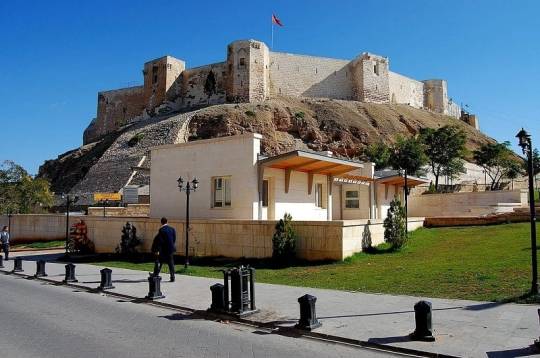

Ancient Gaziantep Castle Used by Romans and Byzantines Destroyed in Turkey Earthquake
An ancient castle in Turkey was one of the historic monuments damaged when major earthquakes hit the country and neighboring Syria, killing more than 2,000 people on Monday. Images show parts of the Gaziantep Castle, which was first built in the 2nd and 3rd centuries AD, during the Roman Empire, crumbling after the earthquake.
The 2,000-year-old castle is located in the Gaziantep region, about 80 miles south of the epicenter of one of the quakes in Kahramanmaras Province.
The castle, an archeological site, sits near the Gaziantep Archeology Museum, which includes works of the Late Hittite and Roman Periods during which the castle was built.
While there is no definitive information about when the castle was fist built, it was founded on top of an earthen mound that dates back some 6,000 years, to when an ancient city called Theban occupied the space.
It is believed to have been constructed as a watchtower during the Roman period between, the 2nd and 4th centuries AD. However, it was built up even more during the 5th century AD during the reign of Byzantine Emperor Justinianus, who was known as the "Architect of Castles."
The Ottomans repaired the castle over time, but it got a second full overhaul by Egyptian Sultan Qaitbay in 1481. There are 12 towers on the castle and the two towers near the main gate were rebuilt in 1557 by Suleiman the Magnificent during the Ottoman Empire.
By Caitlin O'Kane.
#Ancient Gaziantep Castle Used by Romans and Byzantines Destroyed in Turkey Earthquake#Gaziantep Castle#Gaziantep Archeology Museum#Byzantine Emperor Justinianus#Architect of Castles#Suleiman the Magnificent#archeology#archeolgst#ancient artifacts#history#history news#ancient history#ancient culture#ancient civil#roman empire#roman history#ottoman empire#byzantine empire#earthquake
104 notes
·
View notes
Photo

THE VARNA TREASURE
31. THE VARNA TREASURE
The treasure was fortuitously found in Varna in 1961, during construction works, at the corner of Knyaz Boris I and Makedonia streets, 1,5 m be-low the today’s walking level. The spot is about 500 m north – east to the Late Antiquity fortress walls of Odessos, near the Roman necropolis of the town (AD 2nd – 3rd centuries). At the area of the find there is evidence of funerals dating from the 4th – 6th centuries.
It has been probably kept within a leather sa-chet and might have been part of a larger treasure
consisting of gold jewelry belonging to ecclesiastical or secular persons. The presence of additional artifacts and fragments suggests the treasure has been divided in two parts at least, and submitted by the Church or by Odessos authorities in the second half of the 6th – early 7th century to Barbarians (probably the Avars who invaded the Balkans in 580 – 582) in return for captives; the local bishop Martin attested to a similar initiative — in 544 he succeeded in receiving from Emperor Justinian a special privilege for the church community in town (Just. Nov. CXX, 4)
The treasure consists of eight objects or frag-ments of 22-carat gold, precious and semi-precious stones: pearls, garnet and malachite of a total weight of 417 g. They were produced in different periods between mid 5th and mid 6th centuries, using various techniques peculiar of the Early Byzantine goldsmith’s art as forging, engraving, chasing, filigree, granulation, incising, intaglio and encrustment. Some of the pieces were prob-ably fashioned in the imperial workshop of Con-stantinople, as the bracelets tour bulgaria, the incised diadem which is the only one known of its kind, and per-haps the necklace. The rest of the jewels were like-ly produced in the workshops of Odessos, which were very active in the course of 4th – 6th centuries.
31.1. DIADEM
Constantinople Second half of the 5th century Gold, pearls, green gems (emeralds?) 32,5 x 1,3 cm; 16,4 g
31.2. DIADEM A fragment Odessos 6th century Gold, opal, pearls, glass 19 x 1,3 cm; 40,8 g Varna, Regional Museum of History, lnv. N III 560
31.3. NECKLACE
Odessos
Late 5th – 6th century Gold, pearls, glass L. 25,6 cm; 25,6 g Varna, Regional Museum of History, lnv. N III 561
31.4. PECTORAL CROSS -ENCOLPION
Odessos 6th century Gold, garnet, malachite 7,3 x 5,2 x 0,75 cm; 37,5 g
Byzantium
Second half of the 6th century Gold, filigree, amethyst 3,9 x 2,5 cm Sadovets, Pleven region, discovered during archaeological research in 1934, in the vicinity of a Late Antiquity fortress together with 54 gold coins and 50 copper coins dating from the reign of Justinian (527 – 565) to Maurice Tiberius (582 – 602)
31.5. BRACELET
(the other one of the pair is now in a process of conservation) Constantinople 6th century Gold, pearls, glass, enamel 6,3 x 3,4 cm; 109,4 and 112,3 g Varna, Regional Museum of History,
0 notes
Photo

THE VARNA TREASURE
31. THE VARNA TREASURE
The treasure was fortuitously found in Varna in 1961, during construction works, at the corner of Knyaz Boris I and Makedonia streets, 1,5 m be-low the today’s walking level. The spot is about 500 m north – east to the Late Antiquity fortress walls of Odessos, near the Roman necropolis of the town (AD 2nd – 3rd centuries). At the area of the find there is evidence of funerals dating from the 4th – 6th centuries.
It has been probably kept within a leather sa-chet and might have been part of a larger treasure
consisting of gold jewelry belonging to ecclesiastical or secular persons. The presence of additional artifacts and fragments suggests the treasure has been divided in two parts at least, and submitted by the Church or by Odessos authorities in the second half of the 6th – early 7th century to Barbarians (probably the Avars who invaded the Balkans in 580 – 582) in return for captives; the local bishop Martin attested to a similar initiative — in 544 he succeeded in receiving from Emperor Justinian a special privilege for the church community in town (Just. Nov. CXX, 4)
The treasure consists of eight objects or frag-ments of 22-carat gold, precious and semi-precious stones: pearls, garnet and malachite of a total weight of 417 g. They were produced in different periods between mid 5th and mid 6th centuries, using various techniques peculiar of the Early Byzantine goldsmith’s art as forging, engraving, chasing, filigree, granulation, incising, intaglio and encrustment. Some of the pieces were prob-ably fashioned in the imperial workshop of Con-stantinople, as the bracelets tour bulgaria, the incised diadem which is the only one known of its kind, and per-haps the necklace. The rest of the jewels were like-ly produced in the workshops of Odessos, which were very active in the course of 4th – 6th centuries.
31.1. DIADEM
Constantinople Second half of the 5th century Gold, pearls, green gems (emeralds?) 32,5 x 1,3 cm; 16,4 g
31.2. DIADEM A fragment Odessos 6th century Gold, opal, pearls, glass 19 x 1,3 cm; 40,8 g Varna, Regional Museum of History, lnv. N III 560
31.3. NECKLACE
Odessos
Late 5th – 6th century Gold, pearls, glass L. 25,6 cm; 25,6 g Varna, Regional Museum of History, lnv. N III 561
31.4. PECTORAL CROSS -ENCOLPION
Odessos 6th century Gold, garnet, malachite 7,3 x 5,2 x 0,75 cm; 37,5 g
Byzantium
Second half of the 6th century Gold, filigree, amethyst 3,9 x 2,5 cm Sadovets, Pleven region, discovered during archaeological research in 1934, in the vicinity of a Late Antiquity fortress together with 54 gold coins and 50 copper coins dating from the reign of Justinian (527 – 565) to Maurice Tiberius (582 – 602)
31.5. BRACELET
(the other one of the pair is now in a process of conservation) Constantinople 6th century Gold, pearls, glass, enamel 6,3 x 3,4 cm; 109,4 and 112,3 g Varna, Regional Museum of History,
0 notes
Photo

THE VARNA TREASURE
31. THE VARNA TREASURE
The treasure was fortuitously found in Varna in 1961, during construction works, at the corner of Knyaz Boris I and Makedonia streets, 1,5 m be-low the today’s walking level. The spot is about 500 m north – east to the Late Antiquity fortress walls of Odessos, near the Roman necropolis of the town (AD 2nd – 3rd centuries). At the area of the find there is evidence of funerals dating from the 4th – 6th centuries.
It has been probably kept within a leather sa-chet and might have been part of a larger treasure
consisting of gold jewelry belonging to ecclesiastical or secular persons. The presence of additional artifacts and fragments suggests the treasure has been divided in two parts at least, and submitted by the Church or by Odessos authorities in the second half of the 6th – early 7th century to Barbarians (probably the Avars who invaded the Balkans in 580 – 582) in return for captives; the local bishop Martin attested to a similar initiative — in 544 he succeeded in receiving from Emperor Justinian a special privilege for the church community in town (Just. Nov. CXX, 4)
The treasure consists of eight objects or frag-ments of 22-carat gold, precious and semi-precious stones: pearls, garnet and malachite of a total weight of 417 g. They were produced in different periods between mid 5th and mid 6th centuries, using various techniques peculiar of the Early Byzantine goldsmith’s art as forging, engraving, chasing, filigree, granulation, incising, intaglio and encrustment. Some of the pieces were prob-ably fashioned in the imperial workshop of Con-stantinople, as the bracelets tour bulgaria, the incised diadem which is the only one known of its kind, and per-haps the necklace. The rest of the jewels were like-ly produced in the workshops of Odessos, which were very active in the course of 4th – 6th centuries.
31.1. DIADEM
Constantinople Second half of the 5th century Gold, pearls, green gems (emeralds?) 32,5 x 1,3 cm; 16,4 g
31.2. DIADEM A fragment Odessos 6th century Gold, opal, pearls, glass 19 x 1,3 cm; 40,8 g Varna, Regional Museum of History, lnv. N III 560
31.3. NECKLACE
Odessos
Late 5th – 6th century Gold, pearls, glass L. 25,6 cm; 25,6 g Varna, Regional Museum of History, lnv. N III 561
31.4. PECTORAL CROSS -ENCOLPION
Odessos 6th century Gold, garnet, malachite 7,3 x 5,2 x 0,75 cm; 37,5 g
Byzantium
Second half of the 6th century Gold, filigree, amethyst 3,9 x 2,5 cm Sadovets, Pleven region, discovered during archaeological research in 1934, in the vicinity of a Late Antiquity fortress together with 54 gold coins and 50 copper coins dating from the reign of Justinian (527 – 565) to Maurice Tiberius (582 – 602)
31.5. BRACELET
(the other one of the pair is now in a process of conservation) Constantinople 6th century Gold, pearls, glass, enamel 6,3 x 3,4 cm; 109,4 and 112,3 g Varna, Regional Museum of History,
0 notes